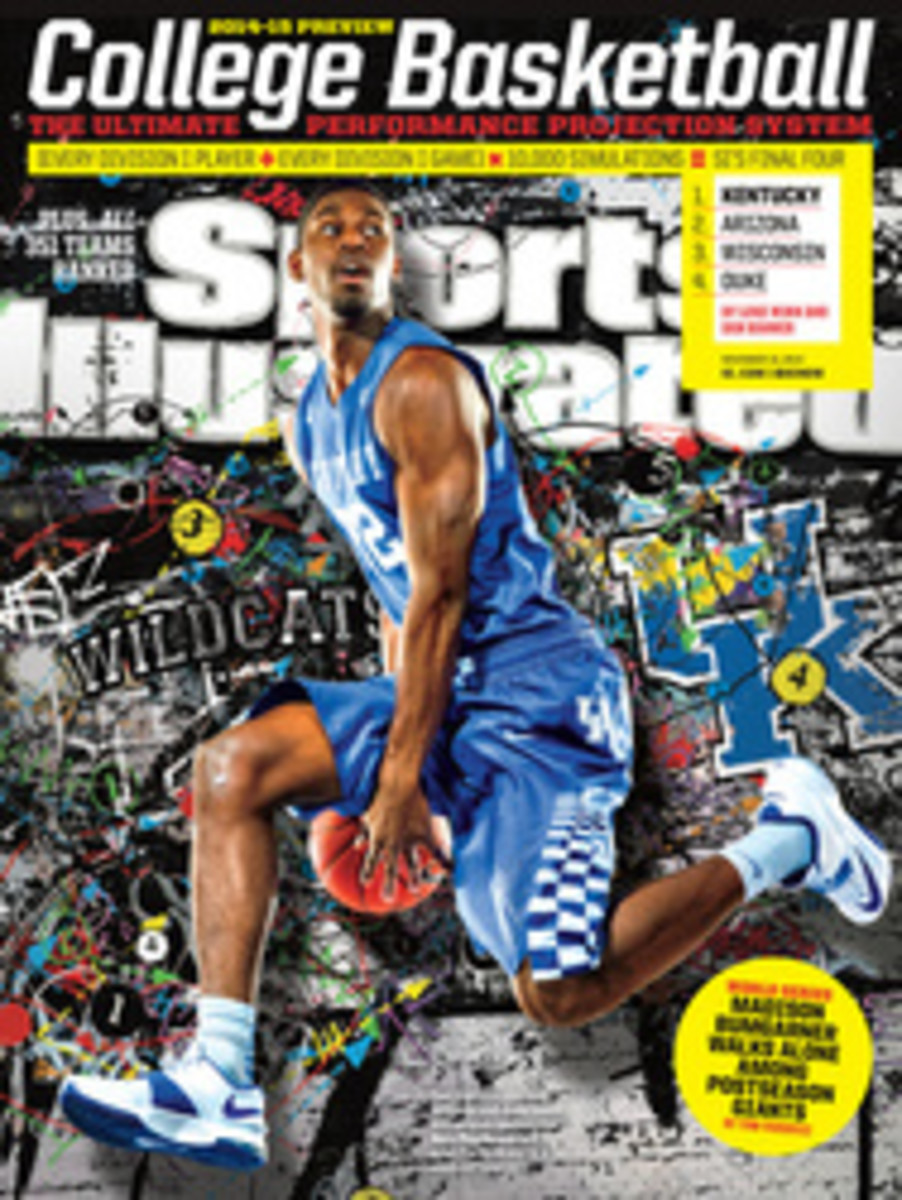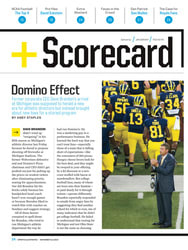
MIND THE GAP
FACING third-and-seven from his own 18-yard line early in a Week 7 home game against the Cardinals, rookie Raiders quarterback Derek Carr barked out signals from the shotgun. He counted off six defenders on the line of scrimmage but felt secure knowing that he had two extra blockers—a running back and a tight end—helping his five linemen in pass protection. But that help wouldn't be enough. Seconds after the snap, the QB was sacked for a nine-yard loss, overwhelmed by the most daunting defensive scheme in football.
Carr's literal downfall had everything to do with two seams along the line of scrimmage, those on either side of the center, between the left and right guards: the A gaps. Slotted amid four linemen, inside the defensive tackles and flanking the center's shoulder pads, were linebacker Larry Foote and strong safety Deone Bucannon, both standing upright. By threatening the A gaps, they created "double-A-gap pressure," a wide-spanning concept that can be executed from any number of fronts and that over the last 15 years has been exploited by defensive coordinators to devastating effect.
All teams attack the A gaps; some, such as the Bengals, Cardinals, Jets and Vikings, do it regularly. Most do it intermittently, with the frequency growing every year. "You used to wait until you played a double-A-gap team, then you'd prepare for it," says five-time Pro Bowl center Nick Mangold, now in his ninth season with the Jets. "With the explosion of that scheme, now you work on it through the spring and at training camp."
And sometimes the mere threat of an A-gap blitz is enough: Many defenses will usually show two A-gap linebackers and blitz neither of them, instead dropping them into coverage and rushing just their four down linemen. But because the offense must assume the extra pressure is coming, it has to respond accordingly, which can tilt the numbers game in the defense's favor. And winning the numbers game, really, is what football strategy is all about.
THE MOST obvious problem posed by a double-A-gap look is the threat it presents of immediate pressure in the quarterback's face, which is always the fastest way to wreck a play. Typically an unblocked pass rusher on the edge can be nullified by a quick-strike throw on a three-step drop-back or a smoke screen (a near-immediate pass to a wide receiver who's been given ample space at the line of scrimmage). But because of the A gaps' proximity to the ball, a defender coming untouched through that hole can still reach a QB. This partly explains the increase in shotgun formations in recent years.
When both A-gap defenders rush, the center can handle only one man. One way to go about nullifying that advantage is through zone blocking—either "squeezing the protection," with a guard stepping in toward the center to create a tight wall, or "sliding the protection," with the whole line blocking in one direction while a running back takes on the exposed defensive end.
But squeezing the protection can leave tackles with even more space to worry about in battling lighter, quicker defensive ends, and it can muddy the blocking assignments as the B gaps (between the guards and tackles) grow. With protection slides, offenses very often end up with a running back or a tight end blocking a defensive end. To address that mismatch, the back and tight end could double-team the D-end—but then the offense has eliminated two of its five eligible receivers, leaving the three remaining pass catchers more susceptible to double coverages.
There's also the option of man blocking, enlisting a running back into one-on-one pass protection against the free linebacker. From the defense's perspective, though, says Foote, "this is the matchup you want." When a defensive coordinator dials up a blitz, he does not expect a clean rusher; more realistically, he hopes for a mismatch like the one created by double-A-gap pressure.
As a Steeler for 11 years early on in his career, Foote played for coordinator Dick LeBeau, who is not only the founding father of the zone blitz—in essence, dropping defensive linemen into coverage and asking cover men to rush the passer—but also one of the game's preeminent A-gap tinkerers. One of LeBeau's A-gap staples is what has come to be known as the Fire X blitz. In this ploy, Foote rushed from his usual stacked linebacker position, attacking the first blocker in the A gap in front of him to create a path for the faster, more explosive Lawrence Timmons to loop around through the same hole. Timmons, also coming from his usual 'backer spot, benefited from an element of disguise as well as a full head of steam, bolstering his advantage over any running back kept in to block.
The Steelers have flourished by employing these types of tactics for years, and several other 3--4 teams, including the Eagles, Jets, Packers and Cardinals, use them today. The most daring of those defensive coordinators have expanded the concept to include a third A-gap pass rusher, generally a safety who blazes through one of the A gaps after two linebackers have attacked it. This particular twist is risky because it leaves multiple pass defenders (oftentimes all of them) in one-on-one coverage, but it's one of the few pressure designs that can guarantee an unblocked rusher to the quarterback.
"Todd Bowles, he's crazy aggressive with those blitzes," Foote says of his defensive coordinator in Arizona. "He'll bring that third rusher even when we're in the middle of the field. He don't care. In Pittsburgh we only did that near the goal line."
NOT SURPRISINGLY, one of the best double-A-gap teams in the NFL is the Panthers, who boast the best nickel linebacking tandem in reigning Defensive Player of the Year Luke Kuechly and stalwart veteran Thomas Davis. They play for a coach who knows the scheme as well as anyone: Ron Rivera was the Eagles' linebackers coach in 1999 when venerated defensive coordinator Jim Johnson introduced double-A-gap concepts to the mainstream.
"Jim was always [asking], What could affect the way the offense protects?" says Rivera. "He started spending time with [offensive line coach] Juan Castillo, asking Juan what affected his protections.... And once he figured out all the little protection nuances, that's how we were going to blitz."
At the heart of that scheme was Jeremiah Trotter, a thundering 260-pound middle linebacker who relished contact. "When the rush is coming from the outside, the quarterback feels like he has more time; he's more patient with his footwork, his release, his follow-through," Trotter says. "But when you get that instant pressure up the middle—not only do they feel it, they see it."
Johnson understood all of the subtle ways in which his double-A-gap looks confounded offenses. He too was known to show blitz, forcing the running back to delay his route out of the backfield, only to have his linebackers drop back, creating one-on-one matchups elsewhere.
After Johnson started dabbling in this science, coordinators further evolved double-A-gap pressure into four-man rush concepts, very similar to zone blitzes, with one of those A-gap linebackers or safeties rushing while a defensive lineman drops back into coverage (page 38).
First-year Vikings coach Mike Zimmer, who spent 14 years as defensive coordinator of the Bengals, Falcons and Cowboys, has long been on the cutting edge of double-A-gap tactics. "We have the ability to [blitz] numerous guys and drop numerous guys out of that look," he says. "That puts a lot of stress on the quarterback, on the backs, on the line and even on the receivers, because they don't really know what [coverage] they're going to get out of it."
Zimmer often buttresses his double-A-gap looks with an edge-blitzing safety, Harrison Smith, who's second among defensive backs with eight QB pressures (sacks, hits and hurries). Cincinnati has continued to find success with similar tactics under new coordinator Paul Guenther, formerly Zimmer's linebackers coach. (No. 1 on that pressures list? Bengals safety Reggie Nelson.) And even some of the more vanilla zone-based defenses, like the Cowboys', have manufactured success with double-A-gap zone blitz concepts. Those are potent because they drop defenders into the quick passing lanes that quarterbacks look to under pressure.
For all of its benefits, double-A-gap pressure is not without its flaws. (If it were, every defense would employ it every play.) It can put added stress on defensive players, specifically linebackers. When 'backers do drop back from this look at the snap, says Zimmer, "they have to be able to do numerous things in coverage: sprint to a spot, understand and see the combination routes, know if we're playing man or zone...."
Even when a team has the proper personnel, double- A-gap pressure can create defensive weaknesses. "You definitely like when a team plays man coverage behind that because you know you're going to get one-on-one opportunities for your receivers," says Mangold. "It also opens up opportunities in the run game. When you commit your linebackers inside, you take away their ability to flow to the ball, so [the offense] gets creases. There are chinks in the armor. It's not a perfect defense. But it is challenging."
BACK IN Oakland, those challenges were apparent. The problem that Arizona caused for Carr started with that classic LeBeau double-A-gap concept: Fire X. At the snap Bucannon gave a stutter step to the center's left, Foote crossed the center's face to attack the opposite A gap, and Bucannon fired behind him. With seven men in protection, the Raiders had felt comfortable blocking man-to-man, but the stunt confused center Stefan Wisniewski for a fraction of a second, and he initially followed Bucannon. Finding himself off-balance when Foote approached at an angle, Wisniewski was easily tossed to the side, and Carr went down in a pile.
In the past year the Cardinals have lost their top two linebackers to suspension and free agency, their best defensive lineman to a torn ACL and their top pass rusher to a series of concussions. And yet Bowles has kept this defense flying. His secret? It lies in the A gaps.
"Todd Bowles, he's crazy aggressive," says Foote. "He'll bring that third rusher even when we're in the middle of the field. HE DON'T CARE."
Most blitz designs aim to force a running back into one-on-one pass blocking against a linebacker, as double-A-gap pressure does. THIS, SAYS FOOTE, "IS THE MATCHUP YOU WANT."
A DOUBLE-A-GAP PRESSURE CONCEPT AT ITS FINEST
In the first quarter of a Week 1 win over the Buccaneers, who are facing third-and-12, the Panthers put six men on the line, forcing Tampa to include running back Doug Martin (1), a poor blocker, in pass protection. Martin will pick up linebacker Luke Kuechly (2) in the left A gap; center Evan Dietrich-Smith will take linebacker Thomas Davis (3) in the right A gap. All other blocking assignments remain standard. Upon the snap, Kuechly rushes—but three of the Panthers along the line, including Davis, drop into coverage (4). Kuechly gets Martin one-on-one and easily beats him (5). Just as damaging for Tampa, three linemen end up with no defender to block (6); they contribute nothing to the play. The Panthers, meanwhile, only rush three, so they are able to drop defenders into an eight-man coverage. The total rewards: three wasted players for Tampa, an eight-on-four advantage for the Panthers in pass defense, plus the Kuechly-Martin mismatch. End result: sack (7), seven-yard loss.
PHOTO
Photograph by Robert Beck Sports Illustrated
CARD TRICKS Arizona's tendency to line up in a six-man line, with a man over each A gap, forces QBs like Carr (4) to change their protections, often adding a daunting chore for running backs such as Darren McFadden (20).
FOUR PHOTOS
NFL REWIND
PHOTO
KIM KLEMENT/USA TODAY SPORTS (SACK)
SIX PHOTOS
ROBERT BECK/SPORTS ILLUSTRATED
CARR WRECK A foray by Foote (50) toward the opposite A gap, as Wisniewski whiffed, put him right in the quarterback's grill. Pressure perfection.

